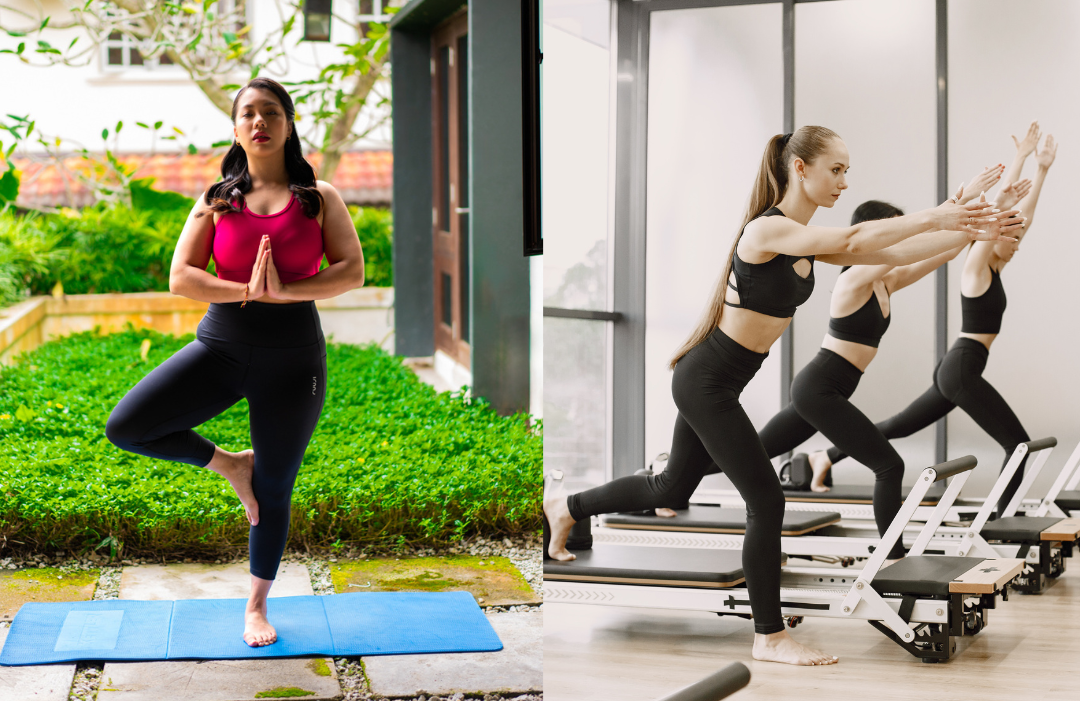
Yoga and Pilates, are they different?

Do you feel like you could use more flexibility or stronger core muscles? Whether you're into bodybuilding or running, incorporating pilates or yoga into your routine can provide substantial benefits. Both disciplines offer unique advantages that can enhance your physical fitness and mental well-being.
However, for those new to these practices, the similarities might be confusing when deciding which class to take. So, what distinguishes pilates from yoga? Let’s explore the key differences in more detail.
Origins and History

The origins of these practices are worlds apart and reflect their different focuses. Yoga boasts an ancient history, originating in Northern India around 5,000 years ago. It evolved as part of spiritual and ascetic practices aimed at achieving harmony between the mind, body, and spirit. The philosophy of yoga includes physical postures (asanas), breathing techniques (pranayama), and meditation, all designed to foster a sense of inner peace and holistic health.

In contrast, pilates is a relatively recent development, created about 100 years ago by Joseph Pilates from Germany. Initially named "Contrology," this method was designed during World War I to help rehabilitate injured soldiers. Joseph Pilates later brought his method to the United States, where it gained popularity among dancers and athletes. Pilates emphasizes controlled movements, core stability, and muscular endurance, focusing on strengthening the body from the inside out.
Breathing Techniques
Breathing is crucial in both yoga and pilates, but the techniques differ significantly. In yoga, breathing is often diaphragmatic, meaning you breathe deeply into your belly. This type of breathing, known as pranayama, is designed to calm the nervous system and enhance mental focus. It plays a vital role in reaching a meditative state, allowing practitioners to connect deeply with their breath and their inner selves.
Pilates, on the other hand, employs a different breathing technique known as lateral or thoracic breathing. Since many pilates exercises require core engagement, practitioners are taught to direct their breath into the sides and back of the ribcage, rather than the belly. This method supports core stability and helps maintain the integrity of the spine during movements.
Spiritual vs. Physical Focus
One of the main differences between yoga and pilates lies in their underlying philosophies and objectives. Yoga is deeply rooted in spirituality and aims to unify the mind, body, and spirit. It often incorporates meditation and chanting, aiming to bring practitioners to a higher state of consciousness and inner tranquility. Classes can vary from gentle and restorative to vigorous and sweat-inducing, but the meditative aspect remains a central theme.
Pilates, conversely, is more focused on the physical aspects of fitness. It aims to enhance muscle strength, flexibility, and balance without the spiritual elements found in yoga. Pilates exercises are designed to improve posture, core strength, and overall body alignment. While it can be mentally engaging, its primary goal is physical conditioning and rehabilitation.
Equipment Use

Both yoga and pilates can be practiced on mats and without any equipment, but pilates often involves specialized machinery. Yoga traditionally uses minimal props, relying mainly on the body’s weight and simple tools like blocks, straps, and bolsters to assist with poses and improve alignment.

Pilates, however, includes the use of unique resistance machines such as the Reformer, Cadillac, and Wunda Chair. These machines add a dimension of resistance and support, enabling practitioners to perform exercises that target specific muscle groups more intensely. The Reformer, for instance, uses springs, ropes, and a sliding carriage to create resistance, enhancing the effectiveness of the workout.
Variety in Classes
Yoga offers a wide array of classes, reflecting its extensive history and diverse practices. Some classes, like Hatha or Yin Yoga, focus on gentle, meditative movements and deep stretching. Others, such as Vinyasa or Ashtanga, emphasize dynamic flows and strength-building poses. Hot yoga, practiced in a heated room, promotes detoxification through intense sweating and vigorous movement.
Pilates classes, while varied, generally maintain a consistent focus on core strength and full-body conditioning. Whether mat-based or machine-assisted, pilates workouts aim to enhance muscular endurance and improve posture. While the exercises have evolved to address modern lifestyle issues, such as prolonged sitting, the core principles of controlled movement and core stabilization remain unchanged.
Instructor Influence

The instructor's role is crucial in both yoga and pilates, significantly impacting the class's nature and effectiveness. A well-qualified and experienced instructor can tailor the class to meet the participants' needs, ensuring a safe and beneficial practice. They can offer modifications for different skill levels and address specific goals, whether it’s improving flexibility, building strength, or achieving a meditative state.
Final Thoughts
Ultimately, the choice between yoga and pilates depends on your personal goals and preferences. If you’re looking for an intense workout that makes you sweat, try hot yoga or a high intensity pilates class. For relaxation and self-connection, a more meditative form of yoga may be ideal. Both practices offer significant mental and physical benefits, so experimenting with both can help you discover which suits you best.
Whether you choose yoga, pilates, or both, incorporating these practices into your routine can enhance your overall health. They can improve flexibility, strength, and mental clarity, offering a well-rounded approach to fitness and well-being. So, grab a mat and explore your local classes to experience the diverse benefits each discipline has to offer.
Enjoyed this post? Share it with others! Join our community for weekly tips and updates on new releases and exclusive events. Stay in the loop with Ruuji.

